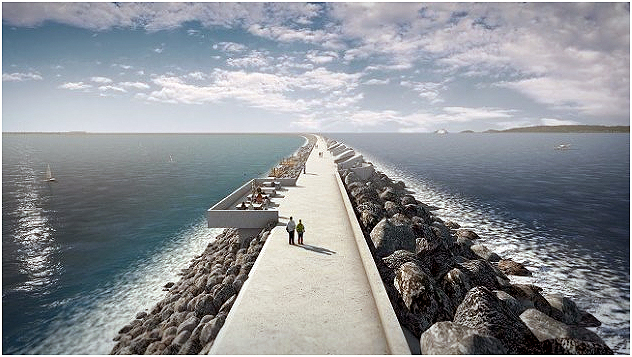Man-made lagoons that harness the power of the ocean’s tides eventually could generate as much as 10 percent of the United Kingdom’s electricity, developers of the first such initiative in Wales claim.
Plans have been drawn up to create a £650 million ($1 billion) tidal lagoon in Swansea Bay in the Severn Estuary, off the coast of south Wales, which could produce enough renewable electricity to power 120,000 homes by 2018.
The lagoon, to be formed by constructing a six-mile, U-shaped sea wall around the bay; would harness the strength of the tides, which would drive 26 large, underwater turbines for 14 to 16 hours a day. Swansea is a particularly good location for this first initiative because it experiences one of the largest tidal ranges— the vertical difference between the high tide and the succeeding low tide— in the world, with a maximum variation of about 33 feet.
The developers at Tidal Lagoon Power of Swansea, Wales, believe that the lagoon, which would be created from local materials, is the most environmentally friendly option for the Severn, which has been at the center of a long-running debate about whether to build a multibillion-pound 10-mile barrage—a type of dam— across the estuary to harness its massive tidal range for electricity.

An artist's rendering of the proposed Swansea Bay Tidal Lagoon (courtesy of Tidal Lagoon Power).
In an environmental impact report released in June on the latest barrage proposal, the U.K.’s Department of Energy and Climate Change found that “a more incremental approach using alternative technologies (such as tidal lagoons) may have the potential to provide a lower-risk, lower-impact option than the Hafren Power barrage scheme.”
Alex Herbert, head of planning at Tidal Lagoon Power, said, "It's not possible to build a piece of infrastructure at this scale without having an impact on the environment; we believe that the impacts are minor, manageable and mitigatable. The environmental impact has been central to everything we've done."
The project, which would save an estimated 210,000 tons of carbon dioxide a year, could receive low-carbon subsidies at levels negotiated with the government. Herbert said the company was confident it would get an agreement in principle in time to meet the requirements for the project.
Mark Shorrock, chief executive of Tidal Lagoon Power, told Wales Online: “It isn’t our place to comment on the barrage, but suffice to say, we have always believed that tidal lagoons are the most viable, cost effective and environmentally friendly alternative to traditional fossil fuel and nuclear electricity production. They combine proven technologies and civil engineering construction methodologies in an innovative configuration to generate predictable, clean electricity for our children, grandchildren and great grandchildren.”
The scheme, which will be submitted for planning approval at the end of the year, includes plans for cycling and walking routes along the sea wall, a visitors’ center, sailing, and other recreational facilities, and aquaculture including the reintroduction of oysters.
The company already has follow-up plans for similar lagoons—with two or three in the Severn estuary, another in North Wales and one more near Liverpool. And therein lies the opportunity to scale production up to the point where it would provide 10 percent of the U.K.’s base load electricity requirement, around the clock.
Tidal Lagoon’s management predicts that construction could generate 3,000 jobs, with up to 40 long-term operations positions and an equal number in recreational management roles.
This would be far from the first tidal lagoon ever built. They date back to the first settlements in the Americas. In Canada, one of the most unique physical features in the marine areas of Victoria is the tidal lagoon called Portage Inlet. This lagoon is connected to Victoria Harbor through a narrow rocky channel called the Gorge Waterway. Two other well-known local tidal lagoons are Esquimalt Lagoon in Colwood and Witty’s Lagoon in Metchosin.
Edited by Alisen Downey
 Internet Telephony Magazine
Click here to read latest issue
Internet Telephony Magazine
Click here to read latest issue CUSTOMER
CUSTOMER  Cloud Computing Magazine
Click here to read latest issue
Cloud Computing Magazine
Click here to read latest issue IoT EVOLUTION MAGAZINE
IoT EVOLUTION MAGAZINE




